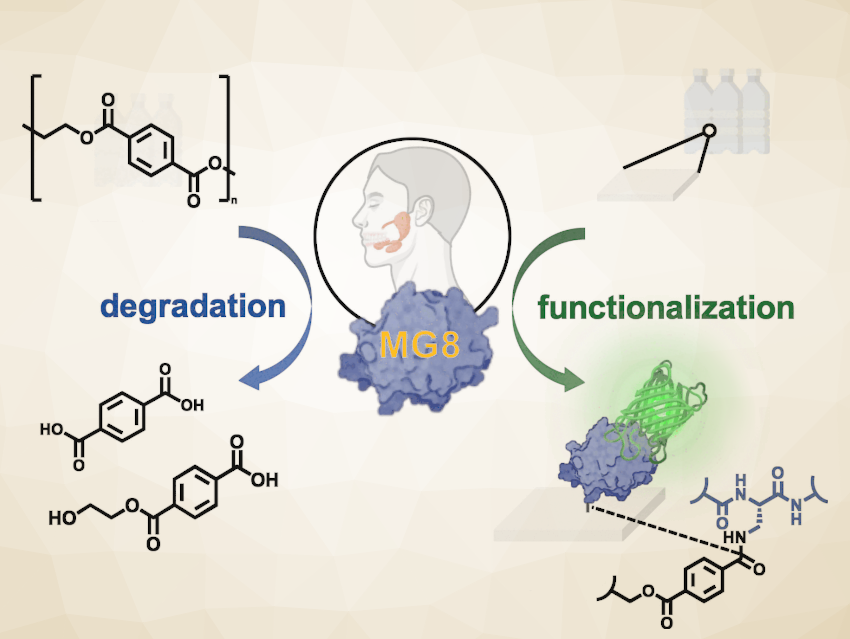Human saliva may contain an enzyme that can decompose the plastic polyethylene terephthalate (PET). Worawan Bhanthumnavin, Chulalongkorn University, Bangkok, Thailand, Chayasith Uttamapinant, Vidyasirimedhi Institute of Science and Technology (VISTEC), Rayong, Thailand, and colleagues have found this promising enzyme, a hydrolase, in a database containing human metagenome samples. This newly discovered hydrolase performs better than many other known bacterial PET hydrolases. It can be produced using biotechnological methods and could be put to use in plastic recycling or for functionalizing plastics.
Enzyme Decomposes PET-Based Plastics
Landfill sites and harbors are known to be particularly promising sites for finding bacteria that have adapted to consume or make use of plastics. These bacteria have evolved enzymes, known as PET hydrolases, which can break PET down into smaller molecules. The team discovered the first enzyme to decompose PET from a rather more surprising source: the genome of microbial communities in human saliva.
The researchers believe that, because humans consume vast amounts of food that has been packaged using PET, microbes in the saliva or the gastrointestinal tract may have evolved to digest microplastics. The team uncovered the new hydrolase, which they named MG8, while searching a public metagenome database containing samples from seawater and human saliva. They were able to attribute the likely source of the enzyme to Gram-negative bacteria that may reside in human saliva. These bacteria are similar to strains found near the “Pacific trash vortex”, which have also evolved to produce PET hydrolases.
They first needed enough material to perform their experiments, and so they modified a bacterium that can be cultured in laboratories to produce the enzyme. They easily recovered an active form of the enzyme, able to decompose PET, from a denatured form that can be isolated in large amounts. The researchers highlight that this shows great promise for scaling up in the future.
Attaching Payloads to PET
Aside from the prospects for recycling scalability, the team also foresees another use of MG8. They discovered that not only can it decompose PET with ease but, with a small modification, it can also bind to it highly effectively. To achieve this, they modified the protein sequence by replacing one of the naturally occurring amino acids (serine) at the active site with an unnatural amino acid, DAP. The modified enzyme immediately adhered to PET powder. This could be used as a vehicle for functionalizing PET surfaces, increasing the versatility of PET in medical devices, for example, and enhancing the versatility of recycled PET.
Despite the promise of MG8 in plastic recycling and functionalization, the team acknowledges that MG8, like other PET hydrolases, still needs some work. For the time being, consumer-grade PET plastics with high crystallinity cannot be decomposed using this hydrolase. Therefore, further research will be necessary to reach the stage where a whole plastic water bottle can be dissolved in a simple solution containing the enzyme.
- Discovery and Genetic Code Expansion of a Polyethylene Terephthalate (PET) Hydrolase from the Human Saliva Metagenome for the Degradation and Bio‐Functionalization of PET,
Bhumrapee Eiamthong, Piyachat Meesawat, Thanakrit Wongsatit, Jariya Jitdee, Raweewan Sangsri, Maturada Patchsung, Kanokpol Aphicho, Surased Suraritdechachai, Nicolas Huguenin‐Dezot, Shan Tang, Wipa Suginta, Boonchoat Paosawatyanyong, M. Madan Babu, Jason W. Chin, Danaya Pakotiprapha, Worawan Bhanthumnavin, Chayasith Uttamapinant,
Angew. Chem. Int. Ed. 2022.
https://doi.org/10.1002/anie.202203061



